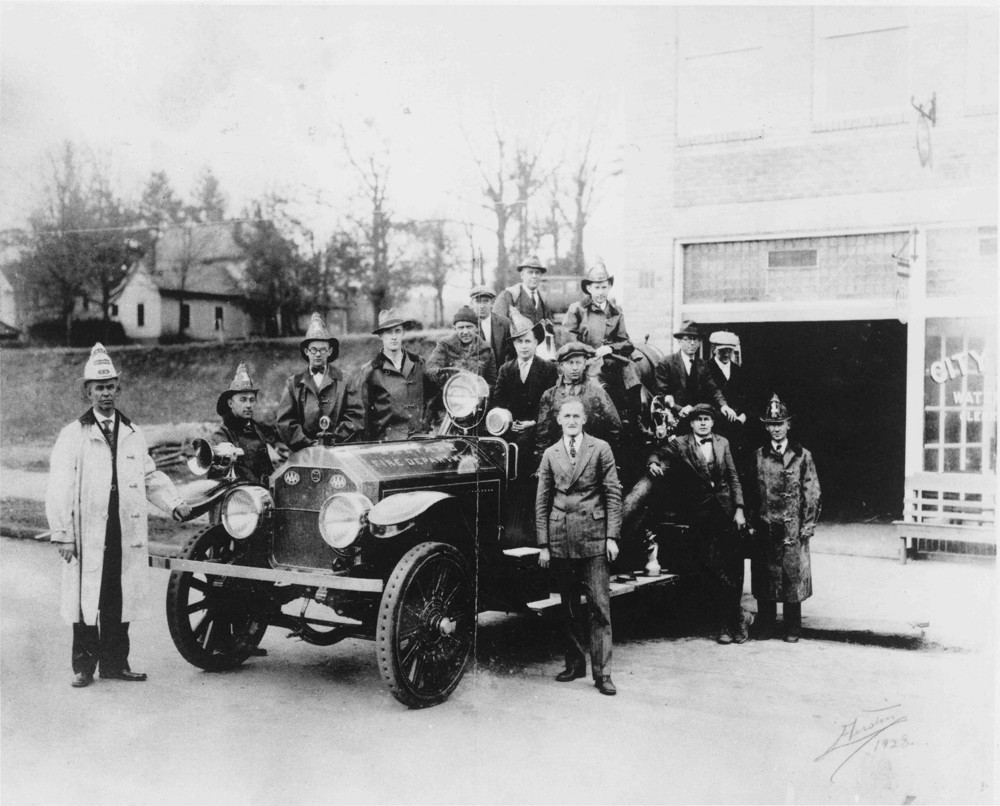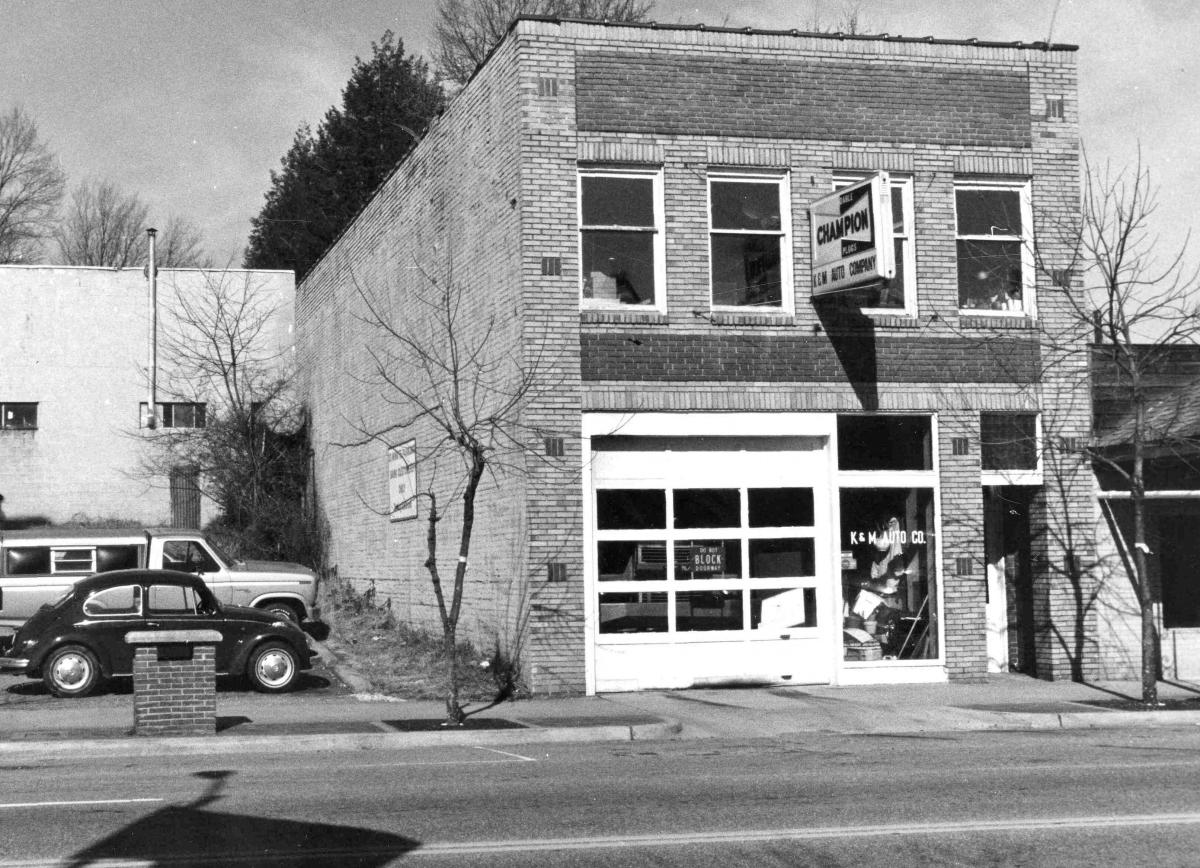See also: Brevard Fire Department: The People Behind the Operations; Fire Departments

The Brevard Fire Department started in 1898 with its main piece of equipment being a “pushcart,” which was upgraded to a Ford truck and in 1925 a large American-LaFrance fire truck. From 1898 to 1969, Brevard’s fire department had six chiefs: Lyon Hume, Chief of Police Sorrells, C. M. Doyle, James S. Bromfield, John Smith, and Daniel S. Merrill. Brevard’s original firehouse, used from 1926 to 1938, was the epicenter of significant local and regional historical developments, especially its firefighting history. But the structure’s importance rests not only in the edifice but also with its leaders who were central to the twentieth-century history of Brevard and the County of Transylvania, serving as a developmental incubator for firefighting leadership that benefitted Brevard and all of western North Carolina. Constructed in 1926, the original fire department building in 2022 houses the Canto 34 Coffee Lounge, located on West Main Street.
The 1926 City Hall-Fire Department Building represented the first municipal building that Brevard dedicated for their designated purposes. From 1939 to 2003, the building operated as K&M Automotive, as well as a Chrysler Automobile dealership and automotive repair shop for city vehicles. The 1926 City Hall-Fire Department Building sits in Brevard’s Main Street Historic District. At the conclusion of the building’s municipal use, the K&M (Kilpatrick and Merrill) Auto Company took over the premises. Robert Kilpatrick, Don Kilpatrick, and Dan Merrill owned and ran the shop which also served as a Chrysler automobile dealership and auto maintenance and repair shop for city-operated vehicles. R.P. Kilpatrick’s son, Don, led the K&M Auto Company with Dan Merrill, all of whom were volunteer firefighters. Merrill would later become chief. The building’s automotive-centered existence ended in 2003.
Transylvania County was formed in 1861 from land taken from Henderson and Jackson Counties. The town of Brevard, the county’s capital seat incorporated in 1868, was named in honor of the Brevard family, early settlers of the area. Because of its location in the mountains of western North Carolina, Transylvania County affords beautiful vistas of nature attracting travelers, visitors, and vacationers; the county has long been known as a “vacation land” and Brevard a “beautiful resort town.” The advancements of the late-nineteenth and early twentieth-century communication and transportation benefitted Brevard as a vacation destination, increasing its population and number of hotels and homes, alongside commensurate increases in local government apparatus to efficiently meet municipal needs, as demonstrated with the start of Brevard’s fire department in 1898.

Between 1917-1941, the United States experienced World War One, the Great Depression, and the start of World War Two, all of which initiated seemingly paradoxical trends of economic growth, decline, and resurrection. North Carolina during most of the twentieth century remained a largely rural state but towns such as Brevard grew rapidly. In 1900, the state’s population was 1.8 million with less than ten percent residing in urban areas. By 1940, the overall population nearly doubled to 3.5 million, with about 975,000 living in urban situations. North Carolina incrementally developed pockets of urban development in small cities and towns such as Brevard whose population increased steadily: in 1910, Brevard was a small “country town of about 1200 people; in 1932, the county seat’s population nearly doubled to 2339; then doubling in 1967 to 6000 residents; as of 2021, Brevard’s population numbered 7755.
The mass production of automobiles in the 1920s and increased highway construction statewide in the 1930s helped the state earn the moniker of a “good roads state,” thus facilitating broader travel, vacationing, and investment opportunities. The Asheville Citizen-Times reported that investors were coming to “Brevard with money.” Brevard was ripe for economic growth, boasting “more miles of paved streets in proportion to population than any other city in the state,” with sufficient water and sewer mains able to supply needed pure water and an efficient volunteer fire department, providing “excellent protection against fire hazards.” With new fire equipment on order, and a fire house planned, Brevard’s local government in the 1920s to the 1930s provided investors assurances of the city’s continued fire safety efforts.
The National Fire Protection Association maintains that fire protection functions that local governments provide should pursue two primary goals: fire prevention and fire suppression. Professional fire-fighting organizations have used the latter two to evaluate a fire department’s efficiency, and Brevard’s Volunteer Fire Department performed these admirably, so much so that Brevard’s Department helped shape firefighting protocols throughout all of western North Carolina. From 1926 to 1938, the years when headquartered at the 1926 City Hall-Fire Department Building, Brevard’s Fire Department developed an institution whose leadership would extend to later generations and earn statewide and regional accolades.
The Brevard News headline held that “Praise Due Brevard Fire Department” on April 1, 1926, because of their response to a fire at the Appalachian Hotel; impressively, only nine minutes elapsed after the alarm sounded, the “first stream of water” showered the flames. The story added that Brevard’s Volunteer firefighters did not live in a station-house and all were home in bed sleeping when they received the call to duty. The short time was characterized as remarkable in keeping the fire from spreading to adjacent buildings. The April 1926 article closed with the acknowledgement that Brevard's "volunteer band of fire-fighters" ranked with the best of their class in this section of the state.
Brevard’s institutional and domestic architecture was increasingly influenced by national trends, namely expanding communication and transportation networks. The early 1900s was “the golden age” of architects and planners, when many North Carolinian builders gained prominence for their work when “Every little city had its cluster of prolific architects” and builders. The state’s leaders looked to national sources of professional expertise to establish new institutions and buttress old ones to enhance and maintain the cultural identity of the rural state. State and local governments increased expenditures to improve public services, including fire departments. In Brevard, structures from this time period continued to mirror its agrarian culture, but with more growth, new buildings reflected the region’s industrial transportation, urban growth needs.